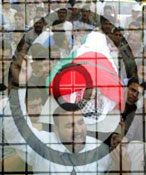Assassination Policy Is a Strategic Folly
 |
Israel's assassination of Hamas leader Abdelaziz Al-Rantissi on April 17 is a continuation of a costly mistake.
In addition to the fact that the policy of political assassinations represents a flagrant violation of international law, the killing of resistance leaders is a counterproductive military strategy as well.
To understand this, a quick look at Gaza during the 1970's is necessary.
Following the military defeat of several Arab countries in 1967 at the hands of Israel, Palestinians sought alternative resistance strategies. One was taking charge of their own fate by espousing popular resistance centered in refugee camps across the occupied territories.
The new tactic was to rely on a form of resistance that is knitted by local militants who are the product of the Palestinians' experience of oppression and defiance. That was the time when the talk of a self-sufficient resistance movement was at its peak.
However, unlike popular rebellions in the past, the 70s witnessed a surge in armed resistance, so resilient and robust, that it baffled the still fresh Israeli occupation.
For a range of reasons, Gaza was the hub of resistance. One obvious reason is Gaza's extreme poverty and overcrowdedness; another is the strip's close proximity to Egypt, which served as an ideological backdrop, especially for Islamic movements.
The 70s' armed struggle introduced yet a new illustration to Gaza's reality dotted with metaphors and symbolisms: The refugee standing in a long line seeking small ration of food provided by some UN facility is now armed and eagerly waiting to battle, often alone, Israeli armored vehicles raiding his camp. Palestinians were determined to become the defenders of their own interests and, despite their unrelenting calls for Arab unity in the face of Israel, they continued to embrace such a resolve. Israel, on the other hand, wanted to ensure full and complete control over the newest conquests by eliminating any influence, even if minimal, of the "troublemakers" and "terrorists".
It took Israel several years to win the disproportionate war of the 70s. Not to suggest that the resistance was not fierce enough, for it was to the contrary. But the Palestinian factions that commanded the armed struggle experience in Gaza were new, received little training and possessed limited resources. These groups offered almost nothing to the refugees living in so dire a situation, aside from the chance for recruitment. That relationship was further hampered by the ideological blurriness that some of these factions infused.
Israel's swift and ruthless military strikes left the local infrastructure of these groups, if any even existed, in a shambles. Almost every member of the resistance was either killed, imprisoned or fled Gaza to Egypt or through Israel to Jordan. Stories of fighters executed in public were all but too common. The armed struggle experiment inside the occupied territories was forced into an early hibernation, forced to yield to the better-prepared and equipped resistance movements outside. But the Israeli invasion of Lebanon in 1982 and the dispersal of the various factions of the Palestine Liberation Organization (PLO) away from their strongholds compelled the return of the idea, and then reality of "homegrown resistance".
Although the Palestinian uprising of 1987 was a popular revolt, stemming from the Palestinian people's outright rejection of the occupation and its ceaseless colonial design, there were repeated calls to better organize and arm the intifada.
Exactly 80 days after the outbreak of the intifada, Hamas was established.
What many rightly note is that Hamas used Egypt's Muslim Brotherhood's ideological framework to structure its own. But many fail to observe that what allowed Hamas to thrust so deep into the Palestinian society and to blossom at such an astonishing speed, was that its existence was essential for the Palestinian society (particularly in Gaza), to avoid complete institutional breakdown.
Unlike the local militias of the 1970s, Hamas was an integral part of the Gaza Strip; it was introduced to Gaza years before it became a full-fledged political and military force under the banner of Hamas, through its vast charity networks, clinics, universities and even daycare centers. While there was a total lack of any municipal governance in Gaza, Islamic movements stepped in, providing what is usually supplied by the regional political leadership.
It was only natural in a highly politicized society that a movement with social and religious dimensions becomes involved in politics and all that politics in an occupied land entails. Palestinian resistance movements fundamentally altered their approach during the late 1980s and early 1990s, by establishing a highly rewarding demographic depth among the population. Unlike the 70s, the tragedy of the killing of one resistance fighter embodied the opportunity of having ten others to join the struggle.
But while Palestinian resistance groups seemed fully capable of modifying the course, the Israeli government reverted to its iron fist policies of the past. The result, as far as Israel is concerned, was disastrous.
Subsequent to the elimination of leading members of the resistance, using the all-purpose justification that those individuals were "terrorist masterminds", new and equally effective leaders would rise and prove as fierce and crafty as all other "terrorist masterminds".
Israel, nonetheless, continued to utilize its "hit list" military mentality. Since the beginning of the intifada, hundreds of activists have been assassinated, but with no avail. It is time Israel realized that the Palestinian will to live in freedom will surpass Israel's infinite weapons stockpile.
Ramzy Baroud is a Palestinian-American journalist and editor-in-chief of The Palestine Chronicle online newspaper. He is the editor of the anthology: "Searching Jenin: Eyewitness Accounts of the Israeli Invasion." Baroud is also a researcher for the Qatar-based al-Jazeera Net English.
To buy "Searching Jenin: Eyewitness Accounts of the Israeli Invasion" CLICK HERE

















